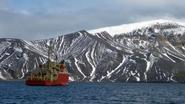
Eugene Domack, J. W. Johnson Family Professor of Environmental Studies, and Mason Fried '10 are leaving on Friday, March 20, on a National Science Foundation-funded expedition to Antarctica on the U.S. Antarctic Program's research and supply vessel LM Gould. The three-week expedition will include visits to several locations along the western side of the Antarctic Peninsula including Palmer Station.
The scientific goals of the expedition are to establish three bedrock Global Positioning Systems (GPS) which will be interfaced with satellite telemetry, according to Domack who is serving as the expedition's chief scientist. These stations are part of a network of GPS systems to be deployed around the northern Antarctic Peninsula. The measurements obtained from the instrumentation will be used to evaluate the past loading of the earth's crust from ice sheets that once flowed across the region and to measure the year to year gain or loss of water to the ice masses currently encapsulating the mountains of the Antarctic Peninsula.
At present very little information is available on the contribution of these glacial systems to global sea level rise. They remain a large unknown in estimates of future sea level rise as the region continues to warm. The last great ice sheet to cover the region may have done so in ways that have influenced the behavior of current ice shelves, which are just now disintegrating as climate changes.
Domack will receive engineering assistance from Bjorn Johns of UNAVCO, a non-profit membership-governed research consortium dedicated to supporting and promoting high-precision measurement techniques for the measurement of crustal deformation. This expedition is part of the LARISSA campaign, a National Science Foundation funded initiative that will bring an international, interdisciplinary team together to address a significant regional problem with global change implications, the abrupt environmental change in Antarctica's Larsen Ice Shelf System. It is also part of the large polar GPS network called POLENET or The Polar Earth Observing Network, a collaborative project in which international scientists and engineers are working together in the polar regions to understand how the earth's surface responds to the changing size of polar ice sheets.
Mason Fried will be continuing his research, a portion of which he presented at the fall meeting of the American Geophysical Union. He wrote "A Radial Pattern of Six Paleo Ice Streams Emanating from the Bruce Plateau Ice Dome, Antarctic Peninsula Ice Sheet: Constraints from Multibeam Bathymetry and GPS Rebound," with Domack and professors from Universitat de Barcelona ans Newcastle University, U.K. The paper is "pertinent to realizing the effect of moderate ice sheet size during collapse and resulting sea level rise," Fried wrote. "It provides the framework for the most detailed and well constrained ice sheet reconstruction for any sector of the Antarctic margin and will therefore serve as a test case for temporal variations in ice thickness, potential flow rates and substrate conditions."
Domack will participate in a longer, two-month expedition to Antarctica in 2010 which will be documented by a team from the National Geographic Magazine. He has participated in 20 field seasons in Antarctica, 13 as chief scientist. The National Science Foundation has supported his research since 1987.
Posted March 20, 2009

